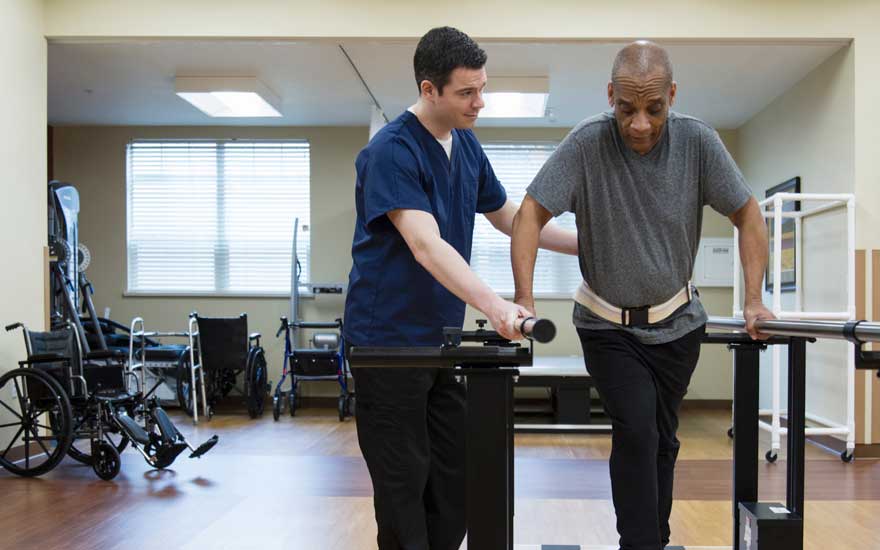Physical Therapy Guide to Traumatic Brain Injury
Traumatic brain injury occurs when an injury disrupts the way the brain functions. The most common causes of TBI are falls, car crashes, and blows to the head. There are 2.8 million cases of TBI diagnosed each year in the United States. Concussion, which is a mild TBI, makes up approximately 80% of all diagnosed TBIs. Traumatic brain injury can happen to anyone. However, some people are at higher risk than others. Children under the age of 4 are at risk of injury from falls and child abuse. Adolescents aged 15 to 19 are at an increased risk due to sports injuries and car crashes. People aged 75 years and older are at risk from falls.
CAUTION: If you have experienced a head injury, seek medical help immediately.
Physical therapists help people with TBI regain their physical function, relearn daily tasks, and restore their fitness and wellness.
Physical therapists are movement experts. They improve quality of life through hands-on care, patient education, and prescribed movement. You can contact a physical therapist directly for an evaluation. To find a physical therapist in your area, visit Find a PT.
What Is Traumatic Brain Injury?
TBI occurs as a result of forces exerted on brain tissue. Common causes of TBI are falls, car accidents, blows to the head, and battlefield injuries. Movement of the brain that causes damage even though the skull is intact is called a closed injury. Damage caused by a wound that breaks through the skull, such as a gunshot or a puncture by a sharp object, is called a penetrating injury.
Those who sustain moderate-to-severe TBI require specialized hospital and rehabilitative care to address the serious physical, cognitive, and emotional changes that result from injury to the brain. Nearly half (43%) of those who need hospitalization for TBI will have some form of disability 1 year after the injury.
Severe TBI often causes a period of unconsciousness, called coma. During this time, the person may not be responsive to outside stimulation. Consciousness may gradually improve, but many brain functions can be affected by the injury, including those guiding thought, movement, sensation, and behavior.
Signs and Symptoms
Because the brain controls our ability to move, think, sense, and socialize, the symptoms that result from TBI can vary widely. They may include:
- Physical symptoms, such as weakness or difficulty moving the arms, legs, body, and head. The affected person may have difficulty sitting, standing, balancing, walking, or lying down and changing position in bed.
- Cognitive symptoms, which can include difficulty remembering, paying attention, or solving problems. The affected person may have a reduced awareness of these difficulties, which can cause safety concerns.
- Sensory symptoms, which can include changes in vision, hearing, or the sense of touch. Balance senses that are aided by the inner ear may also be impaired.
- Emotional and behavioral symptoms, which can include difficulty in controlling emotions, or a change in personality. If cognitive deficits are significant, the affected person's inability to understand what has happened may result in significant emotional agitation.
How Is It Diagnosed?
Upon arrival at the hospital, a physician will diagnose the level of TBI by assessing factors such as the ability to open the eyes, to speak, and to move in response to a command.
Imaging studies will be conducted (such as MRI, CT scan) to determine what parts of the brain are injured. These scans also help doctor's assess if there is any bleeding or fluid that could be pressing on the brain tissue. A physical therapist often works with the medical team to understand what areas of the brain are injured, so the physical therapy evaluation can focus on potential problem areas.
With a severe injury, a person may arrive at the hospital by ambulance and may be on life support and/or in a coma. Over time, the person will likely be able to open their eyes. Sometimes eye opening is accompanied by rapid recovery of other abilities, such as talking and physical movement. For other people, recovery is slower.
How Can a Physical Therapist Help?

The physical therapist will work with the patient, family, and other health care providers to develop goals and a personalized treatment plan to address the challenges and functional limitations associated with the injury. Depending on the severity of the injury, the patient’s level of consciousness, and the problems the patient has, treatment plans can widely vary.
When a person is said to be in a vegetative state, they are unaware of surrounding activity, but some basic brain functions resume, such as:
- Eye-opening on a regular sleep/wake cycle.
- Breathing.
- Digestive functions.
During this phase, the physical therapist will help with positioning and equipment. These will ensure proper posture and flexibility, reduce the likelihood of any problems, such as the development of pressure wounds, and encourage the individual’s responsiveness to the environment.
When a person is said to be in a minimally conscious state, they show the beginning signs of awareness (the ability to do purposeful things). However, these responses are often not consistent. During this phase, a physical therapist will help with stretching, positioning, and equipment use while working with the individual to increase consistent responses to commands for movement and communication.
As the person becomes more conscious and is able to more actively participate in physical therapy, the physical therapist will use a combination of exercise, task-specific training, patient and family education, and various equipment to help the patient improve:
- The ability to stay alert and follow commands.
- Muscle and joint flexibility that may be reduced after inactivity.
- The ability to move around in bed, to sit without support, and to stand up.
- The ability to balance safely when sitting, standing, or walking.
- The ability to move by strengthening and the practicing of functional activities.
- Balance and coordination.
- Strength and energy, reducing any feelings of fatigue that occur from inactivity or injury to the brain itself.
- A return to sports and fitness activities.
If limitations prevent the return to preinjury activities, a physical therapist can help people with TBI improve mobility and master the use of equipment, such as an ankle brace, a walker, or a wheelchair.
Can This Injury or Condition Be Prevented?
Traumatic brain injuries can be prevented by taking steps to protect the head during risky activities, and by lessening participation in those activities. Awareness of the signs and symptoms of injury can help quicken response time should a TBI occur. To lower the risk of sustaining a TBI:
- Always wear an appropriate helmet when taking part in activities that increase the risk of falling, such as biking, rock climbing, motorcycling, skateboarding, skiing, or skating.
- Always use your car's seatbelts; infants must be secured in an appropriate car seat, according to safety requirements and instructions.
For small children:
- Adults should supervise children in fall-prone areas like playgrounds.
- Use child barriers to prevent home-based falls around areas such as stairs and second-story windows.
For adolescents:
- Educate teens about the many factors linked to death and brain injury in car crashes, including the use of alcohol or other substances, speeding, or texting or phone use while driving.
- Educate teens about mild TBI (see Concussion Guide) or severe injuries related to sports.
For older adults:
- Educate older loved ones about the risk of falls in the home related to daily mobility and housework activities that carry a greater risk of brain injury. Examples include using a ladder or footstool, walking on a wet floor, or vacuuming stairs.
What Kind of Physical Therapist Do I Need?
All physical therapists are prepared through education and experience to treat TBI. However, you may want to consider:
- A physical therapist who is experienced in treating people with neurological conditions/injuries. You may find these physical therapists affiliated with rehabilitation centers that commonly serve individuals with stroke, brain injury, and spinal cord injury.
- A physical therapist who is a board-certified clinical specialist or who has completed a residency or fellowship in neurologic physical therapy and uses the designation NCS (board-certified clinical specialist in neurologic physical therapy). This physical therapist has advanced knowledge, experience, and skills that may apply to this condition.
- Sometimes physical therapists with a strong interest in brain injury have the credential of Certified Brain Injury Specialist (CBIS), from the Brain Injury Association of America.
You can find physical therapists in your area who have these and other credentials by using Find a PT, the online tool built by the American Physical Therapy Association.
General tips when you're looking for a physical therapist (or any other health care provider):
- Get recommendations from family, friends, or other health care providers.
- When you contact a physical therapy clinic for an appointment, ask about the physical therapists' experience in helping people who have traumatic brain injury.
- Be prepared to describe the physical issues and symptoms that are causing the most difficulty following the brain injury.
- Plan to talk about what goals are most important to help increase independence doing daily activities, and to ensure a healthy future.
The American Physical Therapy Association believes that consumers should have access to information that could help them make health care decisions and also prepare them for a visit with their health care provider.
The following articles provide some of the best scientific evidence related to physical therapy treatment of TBI. The articles report recent research and give an overview of the standards of practice both in the United States and internationally. The article titles are linked either to a PubMed* abstract of the article or to free full text, so that you can read it or print out a copy to bring with you to your health care provider.
Schwab K, Terrio HP, Brenner LA, et al. Epidemiology and prognosis of mild traumatic brain injury in returning soldiers: a cohort study. Neurology. 2017;88(16):1571–1579. Article Summary on PubMed.
Taylor CA, Bell JM, Breiding MJ, Xu L. Traumatic brain injury-related emergency department visits, hospitalizations, and deaths: United States, 2007 and 2013. MMWR Surveill Summ. 2017;66(9):1–16. Article Summary on PubMed.
Menon DK, Ercole A. Critical care management of traumatic brain injury. Handb Clin Neurol. 2017;140:239–274. Article Summary on PubMed.
Lendraitiene E, Petruseviciene D, Savickas R, Zemaitiene I, Mingaila S. The impact of physical therapy in patients with severe traumatic brain injury during acute and post-acute rehabilitation according to coma duration. J Phys Ther Sci. 2016;28(7):2048–2054. Article Summary in PubMed.
Beaulieu CL, Dijkers MP, Barrett RS, et al. Occupational, physical, and speech therapy treatment activities during inpatient rehabilitation for traumatic brain injury. Arch Phys Med Rehabil. 2015;96(8Suppl):S222–S234.e17. Article Summary in PubMed.
Bragge P, Chau M, Pitt VJ, et al. An overview of published research about the acute care and rehabilitation of traumatic brain injured and spinal cord injured patients. J Neurotrauma. 2012;29:1539–1547. Article Summary on PubMed.
Mossberg KA, Amonette WE, Masel BE. Endurance training and cardiorespiratory conditioning after traumatic brain injury. J Head Trauma Rehabil. 2010;25:173–183. Article Summary on PubMed.
Weightman MM, Bolgla R, McCulloch KL, Peterson MD. Physical therapy recommendations for service members with mild traumatic brain injury. J Head Trauma Rehabil. 2010;25:206–218. Article Summary on PubMed.
Ontario Neurotrauma Foundation. Guidelines for mild traumatic brain injury and persistent symptoms. Available here. Accessed October 5, 2020.
*PubMed is a free online resource developed by the National Center for Biotechnology Information (NCBI). PubMed contains millions of citations to biomedical literature, including citations in the National Library of Medicine’s MEDLINE database.
Expert Review:
Jul 3, 2017
Revised:
Jul 3, 2017
Content Type: Guide
Traumatic Brain Injury
PT, PhD, board-certified clinical specialist in neurologic physical therapy
The editorial board
You Might Also Like...
Article
Neurologic Physical TherapyJul 9, 2024
Neurologic physical therapists evaluate and treat conditions caused by nervous system diseases or injuries. They care for people of all ages and work with
Health Tips
Recognizing Signs of a ConcussionMar 13, 2024
A concussion is a mild traumatic brain injury. Concussions can be caused by a bump, blow, or jolt to the head or body that causes the brain to move inside
Patient Stories
Physical Therapy Helps Man With a Traumatic Brain Injury Return to CollegeJul 29, 2021
Gerardo was lucky to survive a car crash that launched him more than 40 feet. His physical therapist got him back on his feet.


